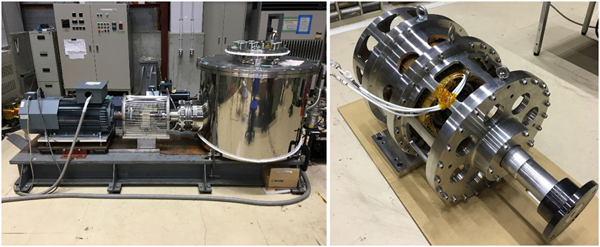AP5-3
Load Test and Efficiency Map Measurement of 50 kW Class Induction/Synchronous Superconducting Machine (HTS-ISM)
Dec.2 09:50-10:10 (Tokyo Time)
Kyoto University, Japan1
IMRA MATERIAL R&D Co., Japan2
The HTS-ISM is a superconducting machine where the squirrel cage is replaced with High-Temperature Superconductors (HTS) tapes. The use of superconductors on the rotor will involve an unconventional behavior. Indeed, the machine has an asynchronous torque. If the relative speed induces a current over the critical current of the bar, the resistivity of the material is no more zero which produces a torque. But the machine has also a synchronous torque, when the machine is driven near the synchronous speed, the currents are trapped into the bar and acts like a magnetized rotor.
This machine is promising for the next generation of transportation. The synchronous state is then interesting because it permits to run at high efficiency. While the asynchronous state increases the stability during overloads. The paper presents a load test where a maximal power of 65 kW was obtained at 1050 rpm and torque over 700 N.m was reached at a slower speed. Moreover, we also purpose in this work to measure the maximal efficiency map of the HTS-ISM for different rotating speeds. The HTS-ISM shows particularly high efficiency.
The experimental setup is shown in Fig. 1. It is composed of the superconducting machine assembled to a 90kW PM machine. The HTS-ISM is confined is its cryostat filled with liquid nitrogen. The superconducting is driven as a motor with a conventional V/f inverter. The PM machine has its own inverter and is used as a load for the superconducting machine. A torque meter is placed between the two machines, the value obtained combined with the rotational speed gives the output power. The input electrical power is monitored on a digital oscilloscope. It is obtained from current measured with clamp meters and voltages measured with differential probes.
The aim of the experiment is to measure the maximal efficiency for each working point: speed and torque. The desired rotating speed is fixed by the inverter frequency and the torque by the load applied to the PM machine. The only remaining variable for a scalar control is the applied voltage of the inverter. The efficiency is then calculated for different values of the voltage and the maximum is kept for the efficiency map.
This work has been supported by Japan Science and Technology Agency under the program of Advanced Low Carbon Technology Research and Development Program (JST-ALCA).
Keywords: Superconducting Machine, High-Temperature Superconductors, Efficiency Map
